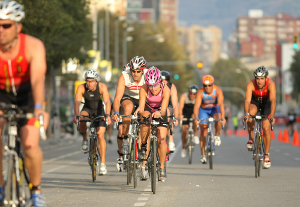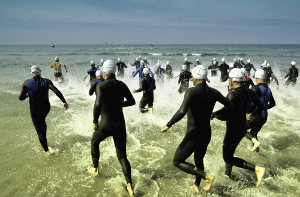How to Choose a Triathlon
 Much of the enjoyment that comes with competing in a triathlon is the thrill of interacting with the course itself. From scenic biking views to rustic running trails, the course can be a large factor in your overall race-day experience. Similarly, other courses can prove to be far more difficult; you will often have to sustain through cold ocean swims, steep hill climbs, and other intimidating conditional variables. This guide provides several important questions to ask yourself when trying to find a race that suits your needs and helps you meet your goals.
Much of the enjoyment that comes with competing in a triathlon is the thrill of interacting with the course itself. From scenic biking views to rustic running trails, the course can be a large factor in your overall race-day experience. Similarly, other courses can prove to be far more difficult; you will often have to sustain through cold ocean swims, steep hill climbs, and other intimidating conditional variables. This guide provides several important questions to ask yourself when trying to find a race that suits your needs and helps you meet your goals.
What’s the Distance?
This is naturally the biggest factor in the race, as the distance can mean the difference between a sub-two-hour event and an event that lasts over 14 hours. Most often, triathlons meet one of four standardized distances: Sprint (15.9 total miles), Olympic (31.9mi), Half Ironman (70.3mi), Full Ironman (140.6mi). Starting at the Sprint tri, the distances basically double as they increase.
When deciding on the distance in which you would like to compete, assess your fitness and training levels along with your overall triathlon experience. Beginners might find themselves better-suited in the Sprint and Olympic distances. If you’ve completed numerous Olympic-distance events, then maybe it’s time to pursue a more challenging event — one of a greater distance. While you should challenge yourself, it’s also important to be realistic in assessing your abilities when choosing an event distance.
What’s the Course Map Look Like?
Keep in mind that scenery often correlates to the course structure and elevation. Events that feature stunning views will most likely require a bit of climbing in order to reach that spot of beauty. Again, this all goes back to your desired experience from the race: are you looking for challenging hill-climbs to overcome or a fast-paced event on a technical track?
The course map is a significant variable in your race-day experience, in regards to both performance and scenery. For example, some courses feature mild rolling hills, while others feature steep hill climbs. If you’re looking for a fast time, a hilly course might not be the best race for you. However, completing the climbs on a hill-filled course can be rewarding in its own regard (and a lot of fun riding down). The best way to assess the elevation of a particular course is to refer to the course-elevation map that is usually found on the event’s website.
Along with elevation, assess the structure of the course itself: Are there loops, multiple laps, out-and-back routes? This detail is not only important for triathletes, but also for spectators. A single-loop course will only allow spectators to see their supported athlete once, whereas a multi-loop course differs in several ways:
- It allows for multiple encounters (which allows for great cheering and photo opportunities).
- It gives competitors the opportunity to familiarize themselves with the course; it can be very reassuring (especially for beginners) when you know what’s around the next turn, or approximately how far you’ve traveled.
- One drawback of a multi-lap course is the repetitive scenery, which can take away from the overall experience of a triathlon.
- A multi-lap course can also feature more technical turns, whereas a single-loop course will generally feature more straights.
Picking a course should all depend on your abilities and goals. Assess what you’d like to gain from this experience and which course map/structure will best help you accomplish those goals.
How Popular & Publicized is the Event?
If it’s your first triathlon, you might want to look into a low-key event that provides a bit more intimacy. If you’re a triathlon-nut, you might prefer a larger, more-publicized event (although you’d most likely compete in both).
As with distance and route pattern, triathlons also vary in popularity. There are races in all parts of the world that are considered "musts" in the triathlon community; there are also races that remain relatively low-key. These great variations have to do with the event coordinators and race sponsors.
Well-publicized events often feature more amenities, such as photographers, a live band, an announcer, a legitimate finish line, and a spectators’ area. Although it is nice to have all these services, a largely publicized event often means a higher attendance rate with an increased level of competition. Be sure to take this into account when assessing how this fits into your race-day goals.
What is the Level of Competition?
 Regardless of the distance, all races will feature various levels of competition. Event difficulty changes upon race popularity and publicity: Is it a well-known event? A widely enjoyed course? Friendly to all ages? What sponsors does the event feature?
Regardless of the distance, all races will feature various levels of competition. Event difficulty changes upon race popularity and publicity: Is it a well-known event? A widely enjoyed course? Friendly to all ages? What sponsors does the event feature?
Organizations are also more likely to coordinate their publicity efforts(such as community involvement through facilitating or competing) around popular events, rather than the smaller ones. The intimacy of a small event might best suit a novice triathlete, whereas experienced triathletes might get the most out of a larger, more challenging event.
What Attractions Does the Event Offer?
Event popularity can also affect the attractions offered to participants and spectators. Larger, well-publicized events often showcase exhibitors and sponsors, who generally set up kiosks for attendees to explore.
Such attractions can be product vendors, supplement companies, and even post-race massage stations. These attractions are not only great for the participants, but also for the spectators, who have little to do in between the athletes’ brief and infrequent visits to (fan-favorite) transition areas. Assess the featured attractions in the interest of yourself, as well as your cheering crew.
What Type of Aid Stations & Amenities are Offered?
This race-related characteristic isn’t the most important aspect to consider when picking out a race, though it's certainly worth thinking about:
- Some races offer one water station throughout the entire bike portion, whereas others offer five or six.
- Some races provide mid-race snacks, sports drinks, hosing (to cool down), and other benefits.
The amenities offered usually depend on the race’s popularity and production value. Most often, the longer races (Ironman, Half IM) will provide more food-related aids, whereas the shorter races (Sprint, Olympic) will offer more hydration-related aids.
How Accessible is this Event?
If the event is held in an uninhabited location, keep in mind that nearby food accessibility might be limited, as well. Prepare all of your race-day priorities the night before to allow for a stress-free event.
Because triathlons require a swim, usually held in a large, natural body of water, most events are held in a relatively remote location. As such, accessibility to reach this out-of-the-way location can result in a lengthy commute. Triathlons are also known to start early (sometimes as early as 5 a.m.), so race-day commuting might result in a sleep-compromising 3 a.m. departure.
Alternatively, hotels can reduce the hassle of early morning commuting. However, as previously identified, the isolated nature of most race locations might result in a lack of nearby lodging. Some events are held at lakes that offer campground areas. Triathletes have been known to camp at the site of the event to allow for the least amount of hassle when making their way over to the event.
What’s the Parking Situation?
Some events require participants and spectators to park in designated areas. Often, these parking spots are near the event site. However, some races cannot provide that luxury and only offer remote parking. It's not unusual for events to charge a fee for parking as well.
There can also be instances where all cars within a designated parking zone are restricted from leaving the race site until the race is over. Although parking is not the most important component of a race, it’s wise to think about when choosing an event.
Will This Event Take Me to a Memorable Location?
Whether it’s swimming from Alcatraz Island in the cold San Francisco Bay or biking across the vast, barren rolling hills of the Utah deserts, make sure that your triathlon is a memorable experience. Let the race take you to a location you’ve wanted to travel to, or wouldn’t have access to any other way. Triathlons should be approached with the perspective of “participant vs. the course itself”. With that in mind, pick your course wisely and get all that you can out of it. Make it a positive and memorable experience!
